Julia Platero stands in front of the Baca/Prewitt Chapter Senior Center in Prewitt, N.M., a remote Navajo community of about 1,900, and introduces herself to the lunchtime crowd.
Speaking Navajo, she says her name and identifies the four clans to which she belongs: Edge of Water, Black Streak People, Salt People and Bitter Water. Platero ends by explaining her role as a Blue Cross and Blue Shield of New Mexico (BCBSNM) outreach specialist and tribal liaison and offers health care coverage guidance.
“For us, the clanship is the one thing that really connects us together, creates that close bond, creates that trust,” she says. “They’re more eager to listen to your conversation, what you have to say to them in their language, the Navajo language.”
Platero is among a small team of BCBSNM outreach specialists traveling the state to educate an estimated 200,000 Native Americans about more than 40 categories of Medicaid options. Her proficiency of Navajo is an invaluable asset. Platero speaks the language to almost everyone she meets — no matter whether they understand English — to gain trust, build relationships and effectively assist the Navajo people she serves.
“It really makes you feel honored,” she says. “These are my people. It really humbles you.”
Powerful communication
New Mexico is home to 23 tribes — 19 Pueblos, three Apache tribes and about 50 chapters across the New Mexico portion of the Navajo Nation. Native Americans make up roughly 10% of the state’s population, with 55% of those younger than age 65 receiving health coverage through Medicaid, according to the Kaiser Family Foundation, an independent, nonprofit health care policy organization.
The Blue Cross Community CentennialSM Medicaid plan covers an estimated 9,300 Navajo members. Platero and her team try to reach and educate 60,000 additional Native Americans, including Navajos, who are not enrolled in a Medicaid managed care plan.
“I saw how important it was for all these different places I was going if I speak Navajo” she says. “You have that personal relationship with them.”
Platero discovered the power of language and its strong influence on people’s lives growing up on her reservation in To’Hajiilee, about 30 miles west of Albuquerque. Necessity required her to speak Navajo so she could communicate with her mother, who didn’t learn English.
She attends Navajo tribal meetings and events to explain advantages of Medicaid managed care enrollment and some covered services such as traditional medicine for Native Americans. Platero typically spends hours answering questions and offering help to those who don’t understand their coverage or what’s available to them.
“I get confused, so it’s really good I can understand her,” says Donald Chavez, who met Platero at the Baca/Prewitt Chapter to discuss traditional medicine options.
Trust and understanding
Little more than half of the estimated 300,000 Navajo population speak Navajo, according to the most recent U.S. Census data. Fewer than 3,750 do not speak English, while almost 8,200 say they don’t speak English well.
McKinley County, N.M., which includes Baca/Prewitt, has the second highest number of Native language speakers nationwide, about 30,000.
“If you know how to speak Navajo, you’re very appreciated,” Platero says. “You understand them, where they’re coming from, if they have questions, concerns. You have that personal relationship with them.”
Cecil Lewis Jr., president of the Baca/Prewitt Chapter, agrees.
“To build trust, you have to bring information to their level, to their understanding,” he says. “Speaking the Navajo language will open their mind more. It is very important that they would be addressed in that manner.”
Making individual connections
Over two days, Platero drives more than 275 miles roundtrip from Albuquerque to Gallup to attend Navajo events, including her stop at Baca/Prewitt.
Heading east on Interstate 40 from Gallup, a snow-capped Mount Taylor, one of the four sacred mountains bordering Navajo territory, appears on the horizon. Red rock mesas glow as the sun rises.
While driving, Platero listens to two Navajo radio stations to brush up on the language, which evolves to accommodate modern technological terms, including computer — described in Navajo as metal that thinks for itself.
“The Navajo language is a lot of description, not necessarily one particular word for something,” Platero says, adding some people, depending on location, describe things differently than she does. “I want to be able to use their words, not necessarily mine. That’s how I connect to them.”
At the Baca/Prewitt Senior Center, people take turns meeting individually with Platero, who sits at a table near the back of the center. They pull out various insurance cards, many of which have expired. Platero checks their Medicaid coverage and eligibility.
As she speaks to people, English insurance phrases — patient benefit coordinator and personal care services — often pepper her Navajo conversations. Otherwise, Platero uses little English, which she says many older people prefer. She enjoys the interaction and feels connected to everyone she meets.
Carol Pinto, a senior center visitor, appreciated Platero’s Medicaid expertise, ability to speak Navajo and willingness to help.
“I could ask my questions in Navajo and she understood,” Pinto says. “She talked to everyone. She took time to speak to us.”

